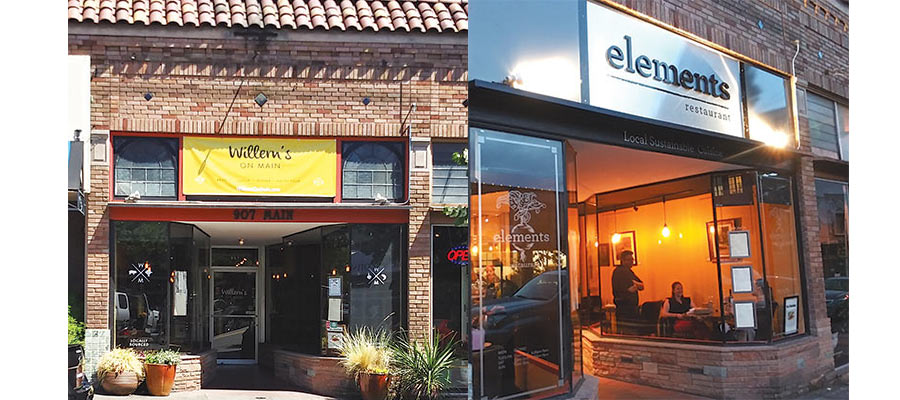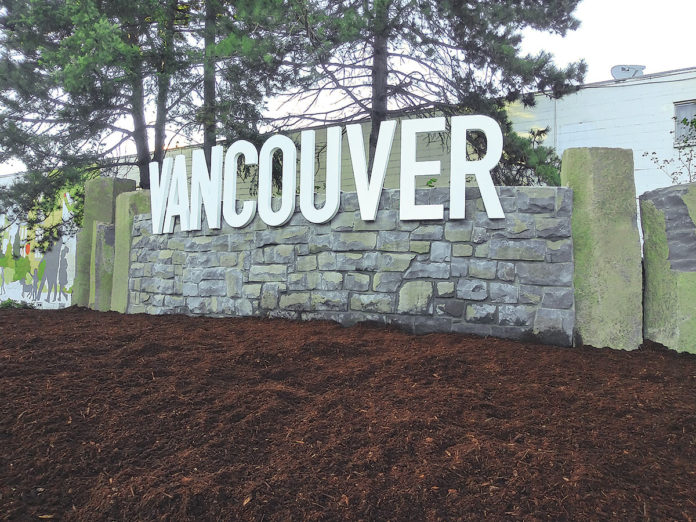Signs are an iconic element of any landscape – urban, suburban and rural – offering clues to the health, vitality and history of a region. While a huge percentage of marketing efforts are directed online these days, the humble store front sign continues to play a crucial role in any brick-and-mortar shop’s success – and the success of those sign makers who persevere in an ever-changing market.
As Sandy Cereghino, a 40-year veteran of the signage business in Vancouver, said, “My motto is ‘A business without a sign is a sign of no business.’”
Operating under Sandy’s Sign and Design, Cereghino started her business in 1980 in her mom’s spare bedroom, and she taught herself the ropes.
“There were few women in the sign business at that time and it is still lacking,” she said. “I had to learn on the job and train myself in every aspect of design, layout and execution of making signs …. It took a lot of knocking on doors, but the one thing about this business – everyone in business needs a sign.”
The technology of sign-making is ever changing, constantly presenting new options for sign makers to take advantage of.
“In the beginning of my career, every sign was hand painted; now I have the latest printers and technology to design and produce signs,” Cereghino said. “The advantage is instant signs. What would have kept a customer’s van or work truck in the shop for days, letting the paint dry, can now be lettered at times in hours.”
Veteran sign makers like Cereghino make use of technology as it changes, but they don’t let it lead their approach to sign making. Technology is a tool, not an end goal. Sign makers seem to follow their passion intuitively, rather than be everything to everyone. Cereghino has painted murals in Seaside, Ore., and the tail of an airplane headed to Haynes, Alaska. Novelty keeps her perspective fresh after nearly four decades in the business.
“I love the sign business. Every day brings something new. Banners, posters, yard signs, decals, vehicle lettering, metal signs and more. I have painted or made signs for planes, trains, boats and automobiles, and pretty much anything you can think of,” said Cereghino. “No matter how large or small, I look forward to the challenge of the design and watching the happiness of the customer when it all comes together. If I feel it is not something I can do, I will find another company that can. I call this my Miracle on 34th Street attitude and hope that when it is something that my shop can handle, they will come back to me.”
Signs & More has been in business since Carl Green started it in 1985. As the story goes, at a trade show he saw a piece of automated equipment targeted toward the sign industry. He invested in the equipment and continued working his day job until he was comfortable enough to start Signs & More a few years later. The first store was in the Heights, then two locations in Hazel Dell. Signs & More has been in its current St. John’s location since 2003.
The company was imbued with an entrepreneurial and flexible spirit from the start. Since the early days of cut vinyl signs, Signs & More has expanded into thermal & digital printing. At one point, Green hired an employee that happened to have experience in engraving, and today a large portion of the company’s work is in trophies, awards and engraving.
Green’s son Kyle had been working at the shop since high school. After graduating from Washington State University Vancouver with a degree in web and graphic design, he realized, “jobs were scarce, and I wasn’t in love with it.” He decided instead to come on full time to Signs & More and today is half-owner of the business.
Mike and Sandy Starks are the owners of Soha Sign, which has been in business in Vancouver since it was founded by Clyde and Pauleen Soha in 1949. Mike joined the company is 1987 and began apprenticing under Clyde. He also encouraged the Sohas to invest in new technologies, the first being a vinyl cutter, which paved Soha’s path toward the new digital age of sign making. In 1993, Clyde and Pauleen retired, passing their beloved homegrown business to Mike.
Mike Starks takes a circumspect view of signage and customer service. He vows never to “sell a customer more than they need” and he spends significant time with each prospective client focusing on educating himself and the customer. Crucial questions include: What will the company’s landlord allow? What are the code restrictions in the part of town the sign will appear? Where will it be placed – and will that be the most effective spot? Will it convey a succinct and useful message?
Sandy Starks speaks almost reverently of her husband’s ability to guide a customer to the right product for their business.
“It’s a very dynamic industry, and technology is changing fast. The competition and the customer are changing as well,” she said.
Sandy attributes the longevity of Soha Sign to her husband’s way with customers.
“A lot of it has to do with experience, and a lot of it has to do with Mike,” she said. “His niche is being able to design super effective marketing pieces. I call it “the eye” – he sees what they need and what they don’t need.”
“We’re not just yelling at people with signs to pay attention,” Sandy said. “We’ve got much more to say and a variety of interesting techniques to help customers position themselves in a very competitive marketplace.”
Mike said signs have to do a lot of heavy lifting at a glance. He focuses on “legibility, purpose and position.” He added, “A picture is the best sign of all because it stirs emotion. Text isn’t that important – ours is a shorter time message with higher pop, simpler legibility and something that makes it memorable.”
Sandy said technology is important, but it tends to improve the way they do what they do, not change the direction of their business. A new trend in signs, for example, is active menu boards.
“The tech we stay up to date on is the equipment that we use to make signs, but we don’t actively go out and buy those showpieces,” she said. “Just because it’s new, it’s not necessarily right for every customer.”










